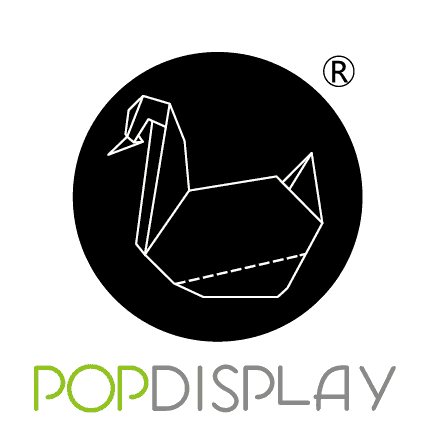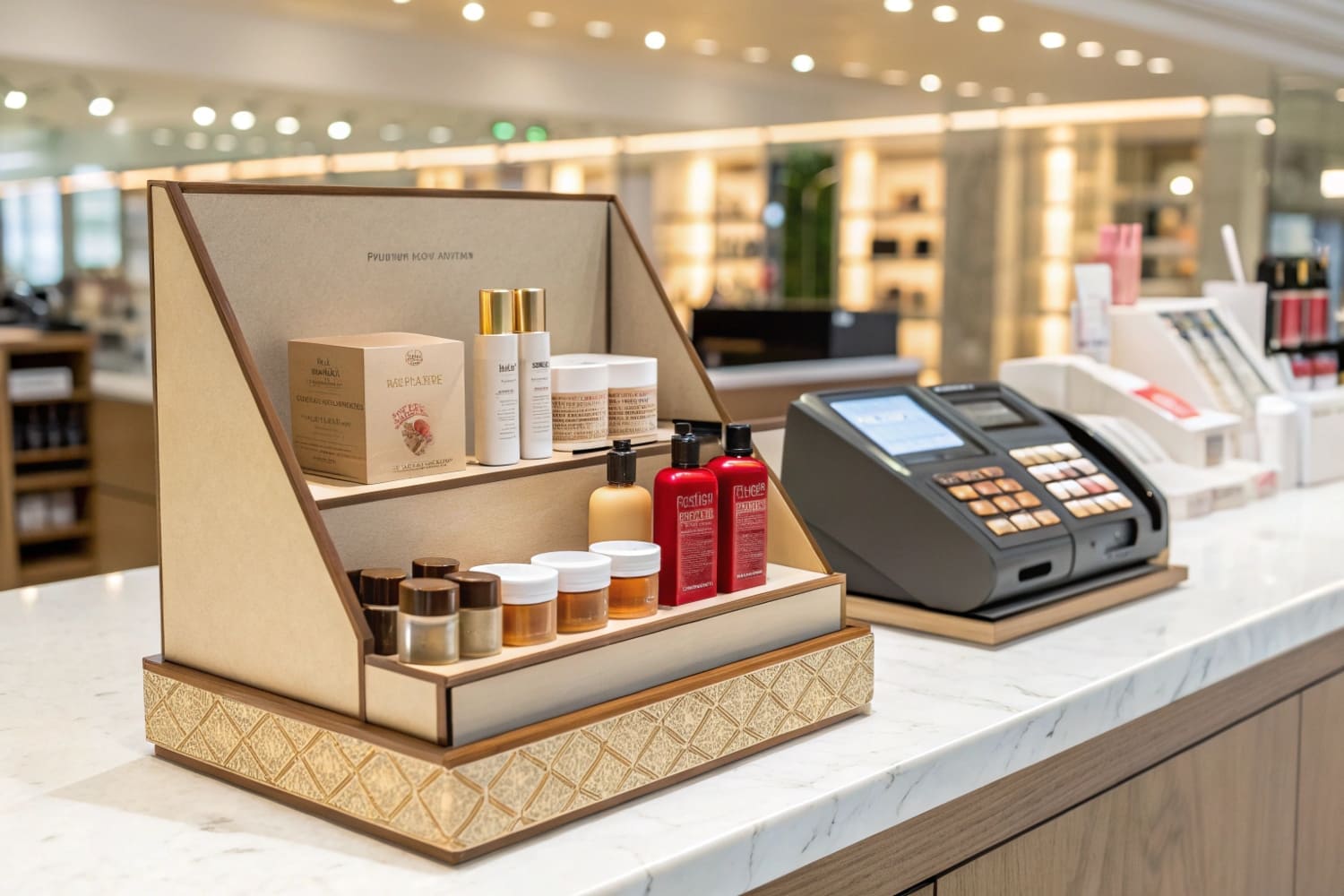I see shoppers rush past shelves. I feel that pressure. I must grab attention fast, hit price points, and win space. I solve that with simple, clear, and strong displays.
Point-of-purchase displays include floor stands, endcaps, pallet displays, countertop PDQs, shelf trays, dump bins, clip strips, and interactive units. I choose the type by location, packout, footprint, timeline, budget, and brand goals.
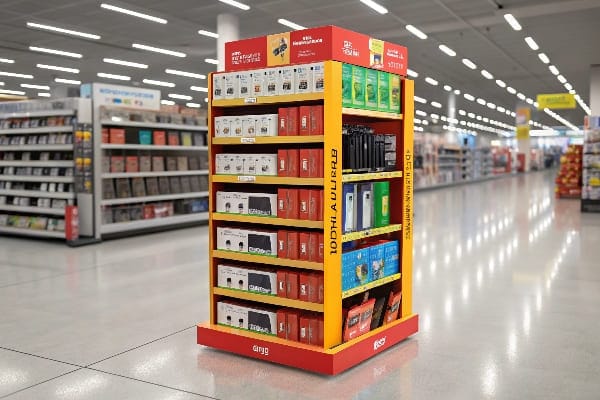
I will break each question down. I will show clear types, fast examples, and simple tables. I will share lessons from my factory floor. I will keep the language plain and useful.
What are the types of point of sale display?
Shoppers decide fast. Space is tight. Staff is busy. I need the right display type to fit the spot, the product, and the season.
Common POS display types are floor displays, endcaps, pallet displays, aisle violators, dump bins, shelf trays, clip strips, power wings, and countertop PDQs. I match the type with product weight, price point, impulse level, and dwell time.
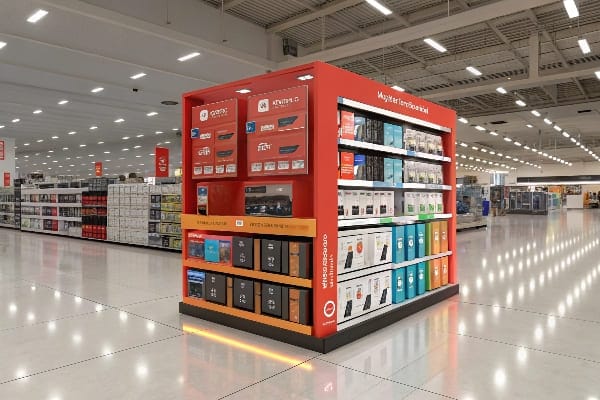
How I map types to store reality
I split by where shoppers pause and how heavy the product is. I also check store rules and ship tests. Floor displays take center stage and often move volume. Reports show floor units can hold the biggest share in many POP segments, which matches what I see. Countertop and power wings trigger impulse near checkout. Pallet displays win in club stores because staff can drop them in fast. I build with corrugated board because it is strong, light, and fully printable. I keep designs flat-pack to cut freight and time. I run water-based inks to meet buyer rules in North America and Europe. I push digital print1 for short runs and fast refresh. In APAC, growth is strong, so I keep modular tools to localize art in days, not weeks.
Quick selector table
| Type | Best Location | Product Weight | Setup Speed | Main Goal |
|---|---|---|---|---|
| Floor Stand | Aisle / Front | Medium–Heavy | Moderate | New launch visibility |
| Endcap2 | Aisle End | Light–Medium | Fast | Traffic interception |
| Pallet Display3 | Club / Warehouse | Heavy | Very Fast | Bulk sell-through |
| Countertop PDQ | Checkout / Counter | Light | Fast | Impulse add-ons |
| Shelf Tray | On-shelf | Light | Fast | Facing control |
| Clip Strip | Near category | Very Light | Very Fast | Cross-sell |
| Dump Bin | High traffic zone | Light | Fast | Clearance / browsing |
| Power Wing | Aisle side | Light | Fast | Secondary placement |
What is an example of a point of purchase display?
Deadlines hit hard. A buyer calls and asks for a fast launch. I need a design that ships flat, sets up in minutes, and holds weight.
A classic POP example is a corrugated floor display with four shelves, printed branding, assembly in minutes, and a QR code for content. Staff places it in an aisle and loads product.
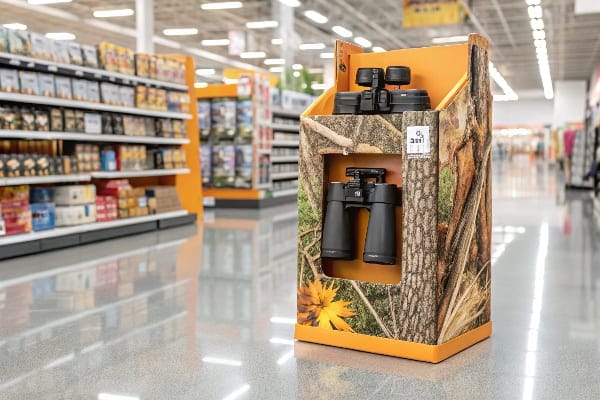
How I ship a fast, strong floor unit
I start with load data4. I confirm product count per shelf and total weight. I spec single-wall or double-wall board by shelf span. I add hidden risers or tabs at stress points. I print digital for speed and color match. I use water-based coating5 for rub resistance. I pack with a color step sheet so staff sets it up right first time. I add a QR to link to video or to warranty. I run a simple drop test and a short vibration test that matches the route. For hunting accessories or tools, I include high hooks or trays with back lips. I keep color simple so brand stands out even under store lights. I mark cartons with large “1/3, 2/3, 3/3” so the team knows the order. This saves minutes and avoids missing parts.
Build plan table
| Step | What I Do | Why It Works |
|---|---|---|
| Load calc6 | Count units × weight | Prevent shelf sag |
| Structure | Add risers / tabs | Increase strength with less board |
| Digital CMYK with spot hits | Fast turns, tight color | |
| Finish | Water-based coat7 | Scratch resistance, eco fit |
| Pack | Flat-pack with step sheet | Faster in-store setup |
| Verify | Drop + vibration tests | Survive transport |
| Engage | QR / NFC on header | Track scans, teach shoppers |
What are the different types of pop displays?
People use POP to mean many things. That causes delay. I keep a simple map that the whole team can follow fast.
POP displays include temporary corrugated units, semi-permanent mixed-material units, and permanent fixtures. I group by placement: pallet, endcap, floor stand, shelf tray, power wing, countertop PDQ, and dump bin.
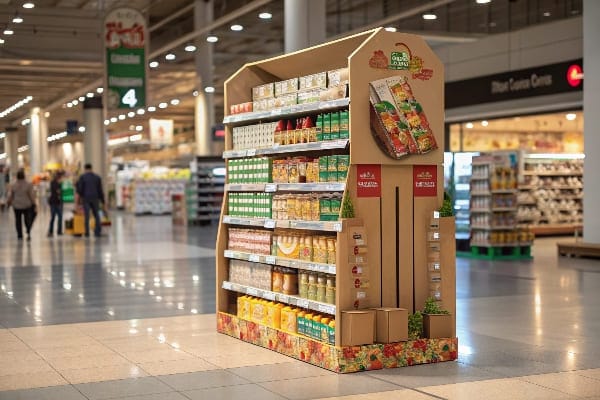
My simple POP framework
I first choose duration. Temporary runs four to twelve weeks and suits corrugated board. Semi-permanent runs up to six months and can add acrylic, metal hooks, or wood caps. Permanent runs a year or more and needs stronger frames. Then I choose placement by shopper flow. Pallet for club stores and fast drops. Endcap for traffic grabs. Floor stand for launches. Shelf tray for facings and tidy counts. Power wing for secondary spots near the main shelf. Countertop PDQ for last-second add-ons. I add small changes for each region. North America favors ship-ready trays8 and PDQ for big box rules. Europe pushes eco claims and clean recycling marks. APAC needs agile art swaps and fast reorders. I design for return on space, not just looks. I remove parts that do not sell more. This keeps cost down when pulp prices move.
Duration × placement table
| Duration | Typical Materials | Common Placements | Best Use Case |
|---|---|---|---|
| Temporary9 | Corrugated board, paperboard | Floor, endcap, power wing, PDQ | Launches, holidays, promos |
| Semi-permanent | Corrugated + acrylic/metal/wood | Endcap, floor, shelf systems | Multi-month programs |
| Permanent10 | Metal, wood, thick acrylic | Aisle fixtures, branded bays | Long-term brand blocks |
What are the four types of point of sale system?
Displays move product, but checkout flow closes the sale. I pick a POS type that matches staff size, store size, and data needs.
Four common POS system types are mobile POS (mPOS), traditional countertop/terminal POS, cloud POS, and self-service kiosk POS. Each type handles payment, inventory, and reporting with different hardware and workflows.
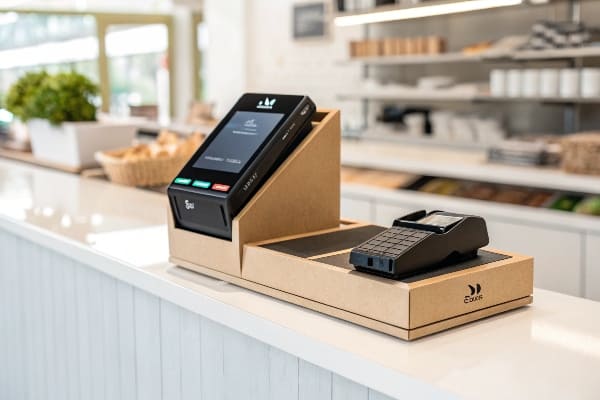
How POS type impacts displays
I link displays with the POS journey. mPOS11 helps staff close near a floor stand during rush. Cloud POS12 syncs stock, so my QR on the header shows live availability. A kiosk at the endcap lets shoppers check size and variants. A terminal POS at checkout pairs with a PDQ for add-ons. I keep NFC tags on displays to log scans by location. This shows which store zones work best. It also guides the next run. I plan power needs only for kiosks; all other units stay passive to simplify setup. I avoid heavy screens on corrugated when the program is short. This keeps cost tight and makes recycling easy. I test receipt copy to include a short survey link. This ties sales back to the display code.
POS comparison table
| POS Type | Where It Lives | Strength | Watch-outs |
|---|---|---|---|
| mPOS13 | On the sales floor | Speed, line-busting | Wi-Fi and device charging |
| Countertop/Terminal | Front counter | Stable, accessories support | Fixed station only |
| Cloud POS14 | Anywhere online | Real-time sync, easy updates | Internet dependency |
| Self-service Kiosk | Endcap / kiosk bay | Self checkout, rich content | Hardware cost, upkeep |
What is the difference between POS and POP displays?
Teams mix these terms. That causes bad briefs and rework. I write them in bold on the kickoff board.
POS is the point of sale system or checkout area that processes transactions. POP is the point-of-purchase display that drives interest and selection anywhere in the store. POS closes the sale. POP creates the sale.
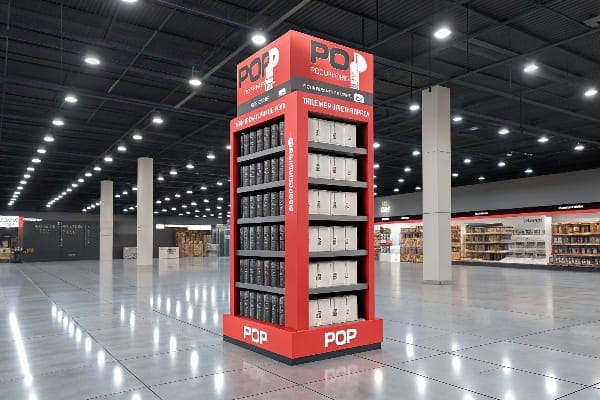
Keep the roles clean
I design POP to earn attention and educate. I add strong headers, clear price, and easy packout. I place it where eyes slow down. I design POS to reduce friction. I keep payment smooth and fast. I use POS data15 to measure the lift from POP. I test A/B with and without the unit. I then adjust copy, shelf span, or graphic blocks. In club and discount channels, I lean on pallet and PDQ formats because labor is tight. In specialty, I add richer copy and hooks. In Europe, I add recycling marks and simple disposal notes. In North America, I add warranty and UPC callouts. When tariffs or freight rise, I condense parts and switch to lighter board grades while keeping strength with smart folds.
Role clarity table
| Term | What It Means | Owner Team | Main KPI | Typical Assets |
|---|---|---|---|---|
| POS | Payment systems and checkout workflow16 | Operations/IT | Basket throughput | Terminals, mPOS, kiosks |
| POP | Marketing displays that drive choice17 | Marketing/Trade | Display sell-through | Floor stands, trays, endcaps |
What are displays and point of purchase materials?
Materials make or break a program. I must balance cost, strength, speed, and sustainability. I choose simple stacks that print clean and ship safe.
POP displays use corrugated cardboard, paperboard, or mixed materials like acrylic, metal, or wood. Common finishes include water-based coatings, eco adhesives, and digital or flexo print. I choose materials by weight, duration, and recycling rules.

My material playbook for speed and strength
I start with corrugated board18 for most jobs. It is light, strong, and recyclable. Single-wall handles many loads if I use smart tabs and risers. I use double-wall or honeycomb pads for heavy items. I print digital for short runs and fast color tweaks. I use flexo or offset for long runs to cut unit cost. I keep inks water-based in most regions. I add nano or water-based coats when stores need scuff resistance or light moisture protection. I avoid plastic films when a buyer wants easy recycling. I label parts with bold numbers to cut setup time. I keep glues low-VOC19. I spec FSC or high-recycled content when buyers ask for it. In APAC growth markets, I keep modular tools so I can swap headers without new dies. This keeps cost stable when pulp or freight moves.
Materials and use table
| Material / Finish | Best For | Pros | Cons |
|---|---|---|---|
| Corrugated (single) | Temporary, light–med load | Low cost, fast print | Lower long-term durability |
| Corrugated (double)20 | Heavier loads | High strength | Higher weight and cost |
| Paperboard | Small PDQs, sleeves | Clean edges, crisp print | Lower structural strength |
| Acrylic / Metal parts | Semi-permanent | Premium feel, rigid hooks | Cost, recycling complexity |
| Water-based coating | Most programs | Scuff resistance, eco fit | Limited high-moisture defense |
| Nano top coat | High traffic, damp zones | Better water/UV resistance | Added lead time |
| Digital print21 | Short runs, fast change | Speed, versioning | Higher unit cost at scale |
| Flexo/Offset | Large runs | Low unit cost, stable color | Longer prep time |
Conclusion
Choose display type by placement, weight, and time. Pair POP with the right POS flow. Keep materials simple, strong, and easy to recycle. Measure, learn, and repeat.
Learn about the advantages of digital print for quick, customizable packaging solutions. ↩
Learn about the strategic advantages of Endcaps in driving customer traffic and increasing sales. ↩
Explore how Pallet Displays can enhance bulk sell-through and attract more customers. ↩
Understanding load data is crucial for optimizing shipping efficiency and ensuring product safety. ↩
Exploring water-based coatings can enhance your packaging’s durability and environmental friendliness. ↩
Understanding Load calc is crucial for ensuring your furniture can support weight without sagging, enhancing durability. ↩
Exploring the benefits of a Water-based coat can help you choose eco-friendly finishes that enhance scratch resistance. ↩
Discover insights on the advantages of ship-ready trays in North America and how they streamline logistics and improve shelf presence. ↩
Explore this link to understand how temporary displays can boost sales during launches and promotions. ↩
Discover insights on how permanent displays can enhance long-term brand recognition and customer engagement. ↩
Explore how mPOS can enhance customer service and streamline transactions in retail environments. ↩
Learn how Cloud POS can help businesses manage stock levels in real-time, ensuring better inventory control. ↩
Explore how mPOS systems can enhance customer experience and streamline transactions on the sales floor. ↩
Discover the advantages of Cloud POS, including real-time sync and easy updates, for modern retail management. ↩
Understanding POS data can help you optimize your marketing strategies and improve sales performance. ↩
Explore this link to understand how to optimize your payment systems for better efficiency and customer satisfaction. ↩
Discover insights on how effective marketing displays can significantly boost your sales and customer engagement. ↩
Explore the advantages of corrugated board, including its strength, lightness, and recyclability, which are crucial for sustainable packaging. ↩
Learn about the significance of low-VOC glues in reducing environmental impact and ensuring safer packaging solutions. ↩
Explore the advantages of corrugated (double) material for heavy loads, ensuring strength and reliability in your packaging solutions. ↩
Learn how digital print technology enhances speed and flexibility in packaging, making it ideal for short runs and quick changes. ↩
